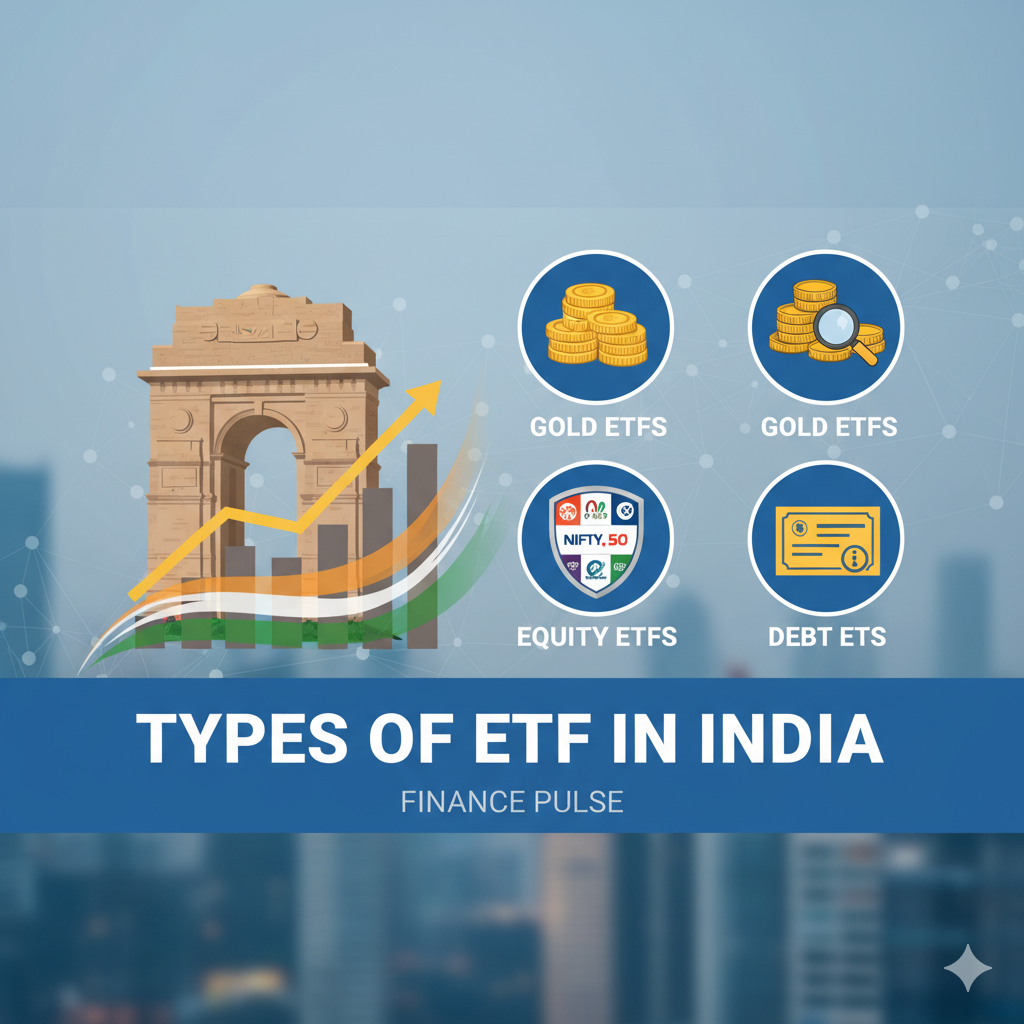Types of etf in india
ETF stands for Exchange Traded Funds. ETFs can be traded on the Stock Exchange. A disadvantage of
mutual funds is that investors can not trade them in real-time on the stock market. When purchasing and selling Mutual Funds, we receive the day-end NAV. But you can trade ETFs in real time in the stock market. ETF price keeps changing like that of shares. We can easily trade them on the stock exchange.
ETFs are a bunch of securities that can be traded on the stock exchange. ETFs can contain Stocks, bonds, and commodities. Since it is a bunch of securities, they are less volatile than stocks. It is impossible that its value becomes zero.
Generally, ETFs follow a particular index. You can compare the ETFs with Index Mutual funds. But the advantage of ETFs is that investors can trade them on stock exchanges like stocks. ETF returns are similar to the returns of its Benchmark index. ETF’s performance will never beat or outperform its index return. Its return is more or less the same as that of the Benchmark Index return.
Since there are no active managers required to manage ETFs. ETFs have a very low Expense Ratio. Their expense ratio is even less than that of index funds.
ETFs are becoming more and more popular among investors all over the world. The advantage of ETFs is that they have the stability of a Mutual fund and can be traded like shares on the stock exchange.

Types of ETF.
ETFs can be broadly divided into three categories.
(1) Equity ETF
(2) Debts ETFs
(3) Commodity ETF
1. Equity ETFs. :-
In this type of ETF, investing is done mainly in the stock market. They can be further subdivided as below.
(I) Index EFTs :
These ETFs follow a particular index like Nifty 50, Sensex, Nifty Next 50, Nifty IT, Bank Nifty, etc. These ETFs follow and invest in these indexes. Some popular ETFs are Nifty Bees and IT Bees. There are ETFs available for investing in foreign indexes, also as NASDAQ, S&P 100 or S&P 500, NYSE FANG, etc.
(ii) Sectoral ETFs
These EFTs follow sectoral themes like pharma, Bank, IT, and infrastructure, and invest in the stock of these theme-based companies. Popular themes are IT, Bank, and Pharma.
2. Debts ETFs.. These EFTs invest in Corporate & Government Bonds, Govt. Securities and fixed-income securities. By investing in these types of Debt ETFs, investors can invest indirectly in a bunch of corporate and Govt. Bonds and securities. Debt ETFs provide investors more flexibility in investment than direct investment in bonds. Investors can sell ETFs easily compared to individual FDs or government bonds.
3. Commodity ETFs... These ETFs invest in the commodity index of a particular commodity. Their values fluctuate up and down as per the market value of the commodity index. Popular types of commodity ETFs are Gold ETF, Silver ETF, Oil GAS, Metal & Mining, Chemicals, Power, etc. Gold EFT is the most popular commodity ETF among investors.
Advantages of ETF Funds.
1. You can invest a very small amount, like Rs. 50 to Rs. 500 in ETF. Price of ETF Nifty IT is just Rs. 35. You can take 10 EFTs of NIFTY IT at Rs. 350 only. You can diversify your investment in TOP IT companies in India. The price of ETF Nifty Bees is Rs. 230=00. You can diversify your investment in the top 50 companies of the Nifty 50 for just Rs. 230. There is no restriction on the minimum investment lot for ETFs. You can even purchase a single EFT.
2… With EFT, you can very easily diversify your investment in equity, debt, and commodities. You can purchase GOLD ETFs to have a GOLD investment in your portfolio.
3. ETF investment is cost-effective. Their expense ratio is much lower than compared of Active Mutual funds. Its expense ratio is even less than that of Passive Index Mutual funds. The expense ratio of ETFs is very low, like 0.01 to 0.03.
4. One of the reasons for the increasing popularity of ETFs is that they can be easily traded live on the stock market. You will get real-time value for it.
Disadvantages of ETFs.
1. EFTs are just like index funds, which follow a particular index. Hence, there is no active manager to pick quality stock for investors. Its returns are the same as those of its benchmark index. It will never outperform the returns of a Benchmark index like an active mutual fund.
2. DMAT AC is required to invest in ETFs. For investing in Mutual Funds, investors do not require a DMAT amount.
Things to remember while investing in ETFs.
1. You should invest in ETFs of a standard Mutual Fund House having a high volume. So that there is no
liquidity problem in buying and selling EFTs.
2. Investors should invest in those ETFs that have low Tracking Error. The tracking error of ETFs you are investing in should be low. Tracking Error means the difference between the actual returns and the returns of the index, the ETF is following.
Conclusion:-
ETF investment is safer as compared to direct investment in stock because investment happens in a bunch of securities or stocks. ETFs give real-time buy and sell options to investors. An investor can diversify their portfolio very easily by investing in various ETFs. In ETFs, the Lot size or sample size is very small. You can even purchase one ETF at a time. It is a very cost-effective investment. Its Expense Ratio is less than the even Expense ratio of the Index fund. For investing in ETFs, the investor requires the DMAT AC and Trading AC.
The reader will also like to read about the following topics
3. PE Ratio
5. Bull vs Bear Phase in Stock Market
6 . XIRR vs CAGR vs Absolute Return
7. Home

